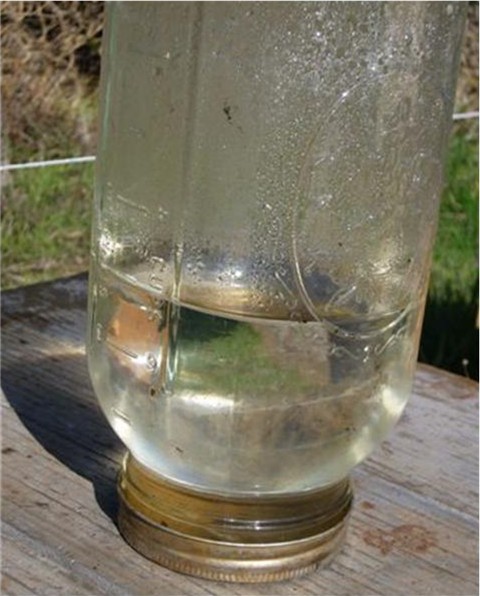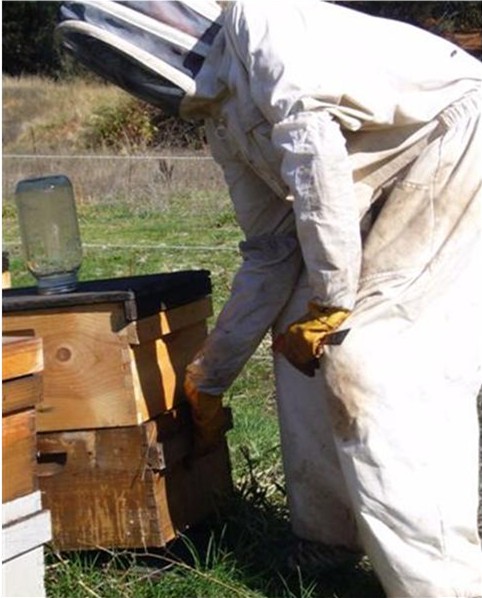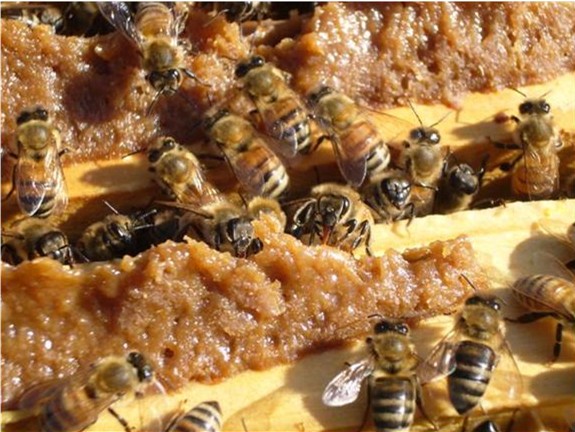Fat Bees – Part 4 Timing and Tummy Aches
Fat Bees – Part 4
Timing and Tummy Aches
© Randy Oliver
ScientificBeekeeping.com
First Published in ABJ in December 2007
No matter how well your bees are fed, the benefit will be moot if they’re unable to digest it!
Syrup Additives
I mentioned last article that light syrup ferments quickly in warm weather, and that bleach could be added to prevent this. There is scant information on the use of bleach to prevent fermentation, and the best recommendation I could find was anecdotal from some old timers, who suggested adding a cup of bleach to each 55-gal drum of syrup.
I know from experience that the chlorine outgassed from bleach is not repellent to bees, judging by how they prefer the water of hot tubs and swimming pools to all other! So I did some research as to the chemistry of bleach, and into food industry recommendations for sanitation. In short, bleach is 5-6% sodium hypochlorite in a weak solution of lye. When slightly acidified during use, it forms hypochlorous acid, which easily penetrates cell walls and oxidizes some metabolic enzymes, thus killing microbes.
The potency of diluted bleach is best measured in ppm of available chlorine. Recommendations for swimming pools are to have 2-4 ppm free chorine; for disinfecting food surfaces 200 ppm. So how strong is 1cup of 6% ultra bleach diluted in 55 gallons of syrup? Pulling out my calculator, I find that it is 32 ppm. However, when I purchased a swimming pool test kit to measure the free chlorine in chlorinated sugar syrup, I found that the 32 ppm figure drops progressively with time, and within 8 hours measures zero! This is for sealed containers with no outgassing of chorine.
So I performed a simple experiment: I filled a quart jar of syrup every hour, adding bleach at 32 ppm, and immediately sealed each jar. At the end of 8 hours I had a series of chlorinated jars, from 1 – 8 hours old, plus an unchlorinated control. At that time I added 5ml of actively fermenting syrup to each jar, and placed them all in an incubator at 80°F. I expected to see a gradation of microbe growth after incubation, due to the stepping down of initial free chlorine concentrations. However, the result was that microbes grew only in the control jar. Even those chlorinated jars that showed zero ppm free chlorine by test, still completely stopped microbe growth for weeks! Apparently, the chlorine binds or reacts with the sugar in a reversible manner, and retains its germicidal qualities.
I fed chlorinated 1:1 sucrose syrup to a few hundred colonies for several weeks this summer, with great results. The bees appeared to build up fine, and my feeder jars did not get the black growth on the insides, and rarely fermented. Fresh chlorinated syrup also disinfects jars that aren’t too dirty. However, it wasn’t as effective in gallon insert feeders. So adding a cup of bleach per drum (or 1 teaspoon per gallon) appears to work fine (although I’d sure like to see one of the bee labs test it for long-term effects). I’ll return to another effective preservative in a later article.

This is a well-used feeder jar. A little bleach in the syrup keeps gunk from growing in the jar and spoiling the feed.
Beekeepers have a long history of adding questionable chemicals to syrup, and the practice still flourishes. Some beekeepers feed or dribble stronger bleach solutions in an attempt to control chalkbrood, although I can find little data as to the efficacy of this practice (although it is commonly used in leafcutter bee culture). It also appears to hold promise as a nosema treatment. Disturbing to me was a recent recipe from the Web that suggested adding a gallon of bleach per 500 gal syrup (works out to 56ppm), plus several bottles of Tylan, plus essential oils, plus vitamins. This is clearly an off-label use of Tylan, which is not approved for use in syrup, due to the likelihood of honey contamination. However, the mixture was more surprising to me in that the Tylan label states that Tylan may react with strong oxidizers (as can vitamins). Bleach is a strong oxidizer, and for all I know, it might make the Tylan in the syrup worthless!
Timing
The honeybee colony is a biological system that goes through an annual cycle, tied closely to the progression of the seasons. The successful beekeeper must always be aware of this fact, and make sure that his management is timely. Timing is everything—nature does not accept excuses nor delays. Supering up halfway through the honeyflow is too late. Feeding after a colony has shut down brood rearing due to protein deficiency is also too late. The beekeeper needs to be observant and proactive.
If you want to maintain colonies that are as big as Sumo wrestlers, they must continually eat like Sumo wrestlers—either from natural forage, or by supplementation. You can’t wait until the last minute to beef up a contender! Feeding only in late fall or winter may be too little, too late. This point was brought home with a vengeance to California beekeepers this season. Our early summer drought shut down colonies in July. Those beekeepers who began supplemental feeding in July now have much stronger colonies than those who waited until late August. It is easy to lose colony “momentum” –once they start to ramp down due to dearth, they are much harder to restart, than they are to maintain with minimal supplementation.
Here’s another nutritional stress tip: The outcome of a stress event is often not apparent until a month or more later. When you see colonies having problems, it may be due a stress event that happened two or more months ago. Beekeepers with problem bees would do well to get in the habit of looking back at events a couple of months prior, in order to try to figure out what happened. Note that one of the common denominators of CCD colonies was a stress event two to three months prior. There is a lag time for the consequences of nutritional stress to appear—it is easy to be caught by surprise, and then it may be too late to do anything about the problem.
I’ve found that by wintering strong, pollen-rich colonies with plenty of quality honey stores, that there is no need for spring syrup feeding. Those colonies build up just fine on their own if they have adequate pollen—either from early spring alders and brassicas, or from supplement. So how much honey should you leave on for the California winter? I just heft my colonies and judge by the grunt. However, for those of you needing a more precise number, I hooked a spring scale to the front cleat, and lifted appropriately heavy colonies until the front rose clear of the ground. The scale read in the range of 60-70 lbs. My son uses a more colorful set of measurements: “If you can heft the front with two fingers, it’s too light. If tipping it up makes your balls hurt, it’s too heavy.” Too heavy is a problem since a honeybound colony has inadequate empty brood comb on which to cluster and later fill with brood.

Hefting a colony for weight in fall. Ian’s saving his back (and other parts) by levering off his knees.
The bees have a natural cycle in temperate climes, and you are fighting their instincts if you try to stimulate them to brood up between the first of November and the winter solstice. However, by New Year’s day, they are ready to roll, if the weather is warm enough (as it usually is in California), and they will respond to feeding if the colony is composed of well-fed winter bees who have not previously reared brood or foraged, and have not been compromised by varroa or nosema.
Bee Digestion
Good nutrition is moot if you can’t digest and assimilate the nutrients. Let’s first look at food assimilation at the colony level. The end use for pollen is to to build up vitellogenin and other protein levels in the hypopharyngeal glands and fat bodies of bees of the right age, and thus to allow them to produce jelly. For this discussion, let’s sort bees into three age groups:
1. Newly emerged “young” bees that are developing their glands, and gorge on pollen.
2. “Mid-aged” nurse bees with developed glands, which can produce jelly to feed to the queen, brood, and foragers. These bees eat enough pollen, if available, to replenish their glands.
3. “Old” forager bees whose glands have atrophied, and who eat little pollen.
Unless the colony has plenty of young and mid-aged bees, feeding pollen will be of little immediate consequence, although it may be stored in the combs for later use. Pollen can only be assimilated well if there is a robust brood nest full of nurse bees and larvae. Brood nest size is limited by the volume that the cluster core can hold at 93°F. The point is, a small cluster of bees in cool weather cover much brood, and therefore can’t assimilate much protein. You just waste pollen supplement in trying to work magic by feeding dinky colonies a big patty!

Nurse bees from the brood nest eating pollen supplement. This is brewers yeast/sucrose cake a week old. Note how it is still moist, and has been eaten away between the frames.
The location of the patty is important, too. It should be in close proximity to the broodnest, since that is where the pollen-eating bees look for food. Patties enclosed within the cluster also remain soft and moist, and are better protected from wax moth and hive beetle. A small colony cannot physically engulf a large pollen patty, and the uneaten patty sets just like cement. The next question you’d have is, “Should I use a cold chisel or a jackhammer to remove the leftovers?”
A colony that has reduced brood rearing during dearth may have few remaining young or mid-aged bees, and will therefore not be able to immediately assimilate much protein (remember the loss of momentum mentioned above?). A hungry colony diverts its efforts toward foraging, rather than broodrearing. Mid-aged are specialized to digest the proteins and lipids (fats) in pollen; older forager bees shift their enzymes toward the processing of nectar (or syrup) (Jimenez 1996). When you start feeding protein supplement, older bees are forced to revert to protein processing, and must shift enzyme production and regenerate their hypopharyngeal glands, which takes a bit of time (remember this point when I discuss Nosema ceranae later). Keep this in mind when feeding. A California colony that shuts down broodrearing in late July will not be able to utilize pollen supplement well in late September, since it will have few nurse bees with the proper enzymes. In addition, bees parasitized by the varroa mite become nutritionally compromised, so August mite control is critical for good nutrition.
Tummy Aches
Not all pollens or supplements are utilized well, due to nutrient imbalances. A deficiency in any essential substance makes that substance a “limiting” nutrient, and limits the utilization of all other nutrients. This is an ongoing problem in the development of a pollen “substitute.” Particle size is also important when considering feedstocks–bees prefer a fine texture (but not too fine).
Bees digest pollen surprisingly quickly—it takes only three hours to pass through the stomach (also called the ventriculus or midgut). Unlike humans, bees do not secrete digestive juices into the ventriculus, they shed the epithelial cells lining the gut, which burst and release their contents, which include digestive juices.
But, just as in humans, digestion doesn’t always go smoothly. Bees are subject to problems due to indigestible sugars, other polysaccharides, or protease inhibitors (as in untoasted soy)—the indigested substances are then subject to bacterial fermentation (as in our own gut when we eat foods such as beans), which can lead to dysentery. On the other hand, certain gut microflora may be involved in producing digestive enzymes—remember this when you consider dosing your bees with prophylactic antibiotics!
Finally, some pathogens compromise the gut. Deformed Wing Virus (which virtually all bees carry) likely affects digestive function (Laurent 2006, Fievet, et al 2006). Amoeba disease and various other organisms occasionally cause problems. But the number one gut disease that you should be aware of are a pair of microsporidians called Nosema—the subjects of my next articles.
References and Further Reading
Fievet Julie, Diana Tentcheva1, Laurent Gauthier, Joachim de Miranda, François Cousserans, Marc Edouard Colin and Max Bergoin (2006) Localization of deformed wing virus infection in queen and drone Apis mellifera L. Virology Journal 2006, 3:16
Grogan D.E., Hunt J.H. (1980) Age correlated changes in midgut protease activity of the honeybee, Apis mellifera (Hymenoptera: Apidae), Experientia 36, 1347-1348.
Jimenez D.R., Gilliam M. (1996) Peroxisomal enzymes in the honey bee midgut. Arch. Insect Biochem. Physiol. 31, 87-103
Laurent, G. (2006) The pitfalls of diagnosis interpretation in honey bee pathology. The case of deformed wing virus (DWV). Proceedings of the Second European Conference of Apidology EurBee
Loidl A., Crailsheim K. (2001) Free fatty acids digested from pollen and triolein in the honeybee (Apis mellifera carnica Pollmann) midgut, J. Comp. Physiol. 171B, 313–319.
Moritz B., Crailsheim K. (1987) Physiology of protein digestion in the midgut of the honeybee (Apis mellifera L.), J. Insect Physiol. 33, 923–931.



